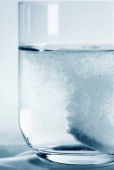
Purpose
To find out how solutes behave when mixed with solvents. After this experiment, you will be able to identify the changes that occurred to the brown sugar when it was dissolved in the different solvents and answer the question, “Which solvent dissolve sugar the fastest?”
Additional information
A solvent is a substance that dissolves another material or substance. It is usually the component of a solution present in greater amount. Many solvents are liquid like water, acetone, and turpentine. Some solvents can dissolve solute faster than others. On the other hand, a solute is any material or substance that is dissolved in a solvent. It is usually the component present in lesser amount. It may be solid, liquid, or gas. Examples of solutes are paint, nail polish, salt, sugar, and powdered soap. You can dissolve solutes in solvents through stirring, mixing, shaking, and other means.
Sponsored Links
Required materials
- nine small beakers
- 1 tablespoon
- 1 cup brown sugar
- 1/2 cup tap water
- 1/2 cup vinegar
- 1/2 cup rubbing alcohol
- stirrer
- stopwatch
- masking tape
- marker
Estimated Experiment Time
Approximately 20 minutes.
Step-By-Step Procedure
- 1. Get the beakers and label them using the marker and masking tape.
- 2. Write “brown sugar in tap water”, “brown sugar in vinegar” and “brown sugar in rubbing alcohol” on the tape and paste them on each beaker.
- 3. Put five tablespoonfuls of tap water, vinegar, and rubbing alcohol in their respective beakers.
- 4. Put one tablespoonful of sugar on each beaker.
- 5. Stir each mixture vigorously with a stirrer and observe what happens.
- 6. Start with brown sugar in tap water followed by brown sugar in vinegar, and lastly, brown sugar in rubbing alcohol.
- 7. Using your stopwatch, time how fast each solvent dissolves the brown sugar. Make sure to stir the solutions using the same circular motion and speed to get reliable results.
- 8. Record your findings.
Note
Measure your solvents correctly by using a measuring cup. You can also ensure you are putting the right amount of solutes by using a measuring spoon. Be careful in pouring the solvents in the beakers to avoid spilling. You may cover your work area with cloth or old newspapers. When stirring, do not stir very hard especially the sides of the beaker since too much force can break the glass. Do not taste or play with the brown sugar and the solvents.
Observation
Based on the experiment, did the tap water, vinegar, and rubbing alcohol able to dissolve the brown sugar? What changes occurred to the brown sugar when it was dissolved in the different solvents? Which solvent dissolved the brown sugar the fastest?
Result
The brown sugar was dissolved in tap water, vinegar, and rubbing alcohol. However, tap water dissolved the brown sugar the fastest compared to the two other solvents. When brown sugar was dissolved, it changed in size until it disappeared or mixed with the solvents.
Sponsored Links
Take a moment to visit our table of Periodic Elements page where you can get an in-depth view of all the elements,
complete with the industry first side-by-side element comparisons!